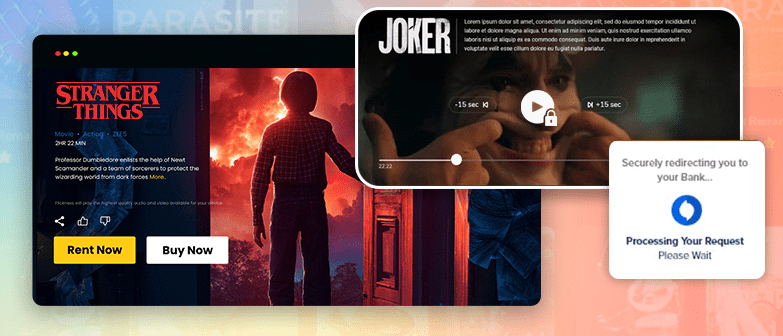“Access_Protect_Prevent_Control_Shield_Deliver your contents with integrating DRM technology.”
Theft issues become the wider challenge for an enormous amount of data drifting in the Information Highway. Data points on all sides of the world have been under monitoring publishers keep on stealing the content. Data security is the most mandatory factor in the video industry.
Industries focus on protecting content, but theft cases occur to influence outcomes in revenue loss each year. So, content builders make specialized decisions towards safeguarding and protecting the contents through Software-based security systems. But the development of OTT content raises its value and providers are demanding strong security specifications in the content-allowing agreements. This impacts the industries to implement an effective approach in the formation of Digital Rights Management technology.
Webnexs Solution offers specialized DRM technology that enables the secure handling of content and grants access to licensed users on allowed devices.
Meaning Of Digital Rights Management
Digital Rights Management is a system that aims to safeguard digital content from unauthorized access, use, and distribution. Its purpose is to prevent piracy and ensure that only licensed users can access digital content. Using DRM is prevalent across several industries, including music, movies, software, and e-books
It works by controlling the access to and use of digital content through various techniques, including encryption, digital watermarking, and access controls. It ensures that only allowed users can access the content and that they do so within the terms of use specified by the content owner.
What is DRM?
Digital Rights Management is a requisite for content builders to preserve their rights. The level of protection in utilizing this technology is instinctively high for maintaining the salient contents. It actually restricts the copy or theft activities of your content by hackers. It assigns a distinct allowing server, stable player, and legalized digital rights to manage the content delivery.
Effective DRM involves a third-party authorization server to provide the decoding keys, a reliable domain to shield the keys, and wipe out with definite content virtue conveyed in the license key file. Also, it provides auxiliary protection by revolving keys, organizing with the confined system clock, and assisting with third-party output security blueprint.
Read more: How does Digital Rights Management work ?
Studio licensing specifications warrant they protect the premium contents from theft at every junction in the streaming servers. Organizations & Regulatory bodies, including GlobalPlatform and Secure Content Storage Association(SCSA) have provided allowed guidelines to help technology and devices to meet innovative security requirements.
Webnexs Solution offers the studio-endorsed DRM to assist & protect your contents beneficially.
By featuring , it becomes possible to manage and control the approach and distribution of video and audio content, including large collections of digital copy-protection outlines. The motive of DRM is to shield the studio’s/creator’s rights.
The Importance of DRM
Here are the reasons DRM (Digital Rights Management) is important:
- DRM helps protect the intellectual property of creators by preventing unauthorized access, copying, and distribution of their work.
- Content owners can use DRM to enforce licensing agreements and control distribution channels to generate revenue from their content.
- It can encrypt content to prevent unauthorized access or distribution, protecting against piracy and theft.
- Some industries, such as healthcare and finance, are required by law to protect sensitive information. It can help ensure compliance with regulations by protecting confidential data.
- It can be used to limit access to content based on specific criteria, such as geography, subscription status, or payment history.
- Provide creators with the flexibility to distribute content in various ways, such as streaming or downloading, while maintaining control over who can access it and how.
- By providing a secure and reliable content delivery system, It can improve the user experience by ensuring that content is available to users when and where they need it.
Overall, It plays a crucial role in protecting the rights of content owners and ensuring the security and compliance of sensitive information.
Types of DRM
There are various types of DRM techniques used to protect digital content. These include:
Digital Watermarking
Digital watermarking is a method used to insert information into digital content can identify the content’s owner. This technique is frequently used to recognize copyrighted content and prevent unauthorized distribution.
Encryption
Encryption is a technique that involves scrambling digital content, making it unreadable without the use of a decryption key. This ensures that only allowed users with the decryption key can access the content.
Access Controls
Access Controls are used to restrict access to digital content. This includes techniques such as password protection, user authentication, and digital certificates.
Benefits of DRM
It has several benefits for content owners and creators, including:
- Protection against piracy and unauthorized use
- Control over the use of digital content
- Protection of revenue streams
- Protection of intellectual property rights
Drawbacks of DRM
Despite its benefits, DRM also has some drawbacks, including:
- Limitations on the use of digital content
- Compatibility issues with different devices and software
- Cost and complexity of implementation
- Risk of security vulnerabilities
DRM and the Entertainment Industry
The entertainment industry is one industry that heavily relies on DRM. Music, movies, and TV shows are often distributed digitally, and are used to prevent piracy and unauthorized distribution.
However, DRM has also been a controversial issue in the entertainment industry, with some consumers arguing that it limits their ability to use and enjoy digital content. Some content owners have also faced backlash for implementing DRM which is overly restrictive and hinders the consumer experience.
Media and Entertainment Cybersecurity Challenges
Media and entertainment companies face several unique cybersecurity challenges because of their business. With digital content becoming increasingly prevalent and valuable, these companies must be vigilant in protecting their intellectual property and sensitive information from cyber-attacks. Here are some of the biggest cybersecurity challenges facing the media and entertainment industry:
- Intellectual property theft: The media and entertainment industry creates and distributes a lot of valuable intellectual property, including music, movies, TV shows, and video games. Cybercriminals can target these companies in order to steal this content and distribute it illegally, causing significant financial harm.
- Phishing attacks: Cybercriminals can use phishing attacks to gain access to sensitive information, such as login credentials or financial data. These attacks can be effective against employees in the media and entertainment industry, who may be more susceptible to clicking on malicious links or opening attachments in emails.
- Ransomware attacks: Ransomware attacks can be particularly devastating for media and entertainment companies, as they can cause the loss of valuable intellectual property and the disruption of business operations. Sometimes, companies may even be forced to pay large ransoms in order to regain access to their data.
- Insider threats: With so many people involved in the creation and distribution of digital content, media, and entertainment companies are vulnerable to insider threats. Employees with access to sensitive information can intentionally or unintentionally leak this information, potentially causing significant harm to the company.
- Third-party risks: Media and entertainment companies often work with a variety of third-party vendors and partners, who may have access to sensitive information. These companies must be vigilant in ensuring that these partners have adequate cybersecurity measures in place to protect this information.
The Future of DRM
The future of DRM is uncertain, with many factors contributing to its evolution. As technology advances, it may develop new techniques to improve its effectiveness and usability. However, as the use of digital content continues to grow, the debate over the use of DRM is likely to continue.
The Impact of DRM on Consumers
It can have a significant impact on consumers, affecting their ability to access and use digital content. While they intend DRM to protect content owners, it can also limit the consumer experience by imposing restrictions on how they can use and access the content.
For example, DRM can limit the ability to make backup copies of digital content, transfer content between devices, or share content with friends and family. These restrictions can frustrate consumers and may drive them towards alternative, unauthorized methods of accessing content.
Acquiring DRM right:
Acquiring the virtue DRM for your streaming service depends on the seller and agreement which you want to execute. A fascinating way followed by studios to stop theft issues is by allowing viewers access right to digital copy through compute /cloud sharing choice.
Implementing multiple DRM:
Apply the protected way of content delivery system by combining multiple DRM services on a Digital rights management service. The service support is used to determine a varied DRM on every occasion by applying advanced logic barriers to switch between protocols depending on the client’s suggestion.
Webnexs Solution designs an integrated Multi-DRM system that projects on all kinds of devices, browsers, & domains for video piracy protection.
It depends on the agreement made by the content providers for implementing valuable services. Configure DRM’s for protecting digital contents in your library, also you have full access permission and admin virtue to the original copy of contents.
Hybrid Digital Right Management:
Combine well-cipher DRM support with effective software automation. This provides a specialized way to deliver strong security features. Many studios search for streaming providers in shielding & distributing the rights to their premium content. For higher security requirements, DRM’s arrived in hybrid – a mixture that uses both hardware/software components to protect content delivery.
A hybrid DRM merges the durability of hardware with the adaptability of software. In a hybrid solution, the most technical security function includes we processed the authentic digital copy of the content to protect hardware while the distribution condition is yet unchanged and unharmed. It also encourages the application of watermarking for digital footprints tracked and analyzed.
CONCLUSION:
It is better to implement allowed DRM technology and effective watermarking features to safeguard your valuable content. Webnexs Solution executes the coherent DRM feature for sheltering the contents and avoids theft & encroachment for ensuring stable content delivery and generates frequent rewards for the streaming business.
Frequently Asked Questions:
1. u003cstrongu003eWhat is DRM?u003c/strongu003e
DRM stands for Digital Rights Management. It is a set of technologies and techniques used to protect digital content from unauthorized access, use, and distribution.
2. u003cstrongu003eWhat types of DRM are there?u003c/strongu003e
There are several types of DRM techniques, including digital watermarking, encryption, and access controls.
3. u003cstrongu003eHow does DRM affect consumers?u003c/strongu003e
DRM can limit the ability of consumers to access and use digital content, imposing restrictions on how they can use and access the content.
4. u003cstrongu003eIs DRM effective in preventing piracy?u003c/strongu003e
While DRM can help prevent piracy and unauthorized use, it is not foolproof and can be circumvented by determined hackers.
5. u003cstrongu003eWhat is the future of DRM?u003c/strongu003e
The future of DRM is uncertain, with many factors contributing to its evolution. As technology advances, new DRM techniques may be developed to improve its effectiveness and usability.


